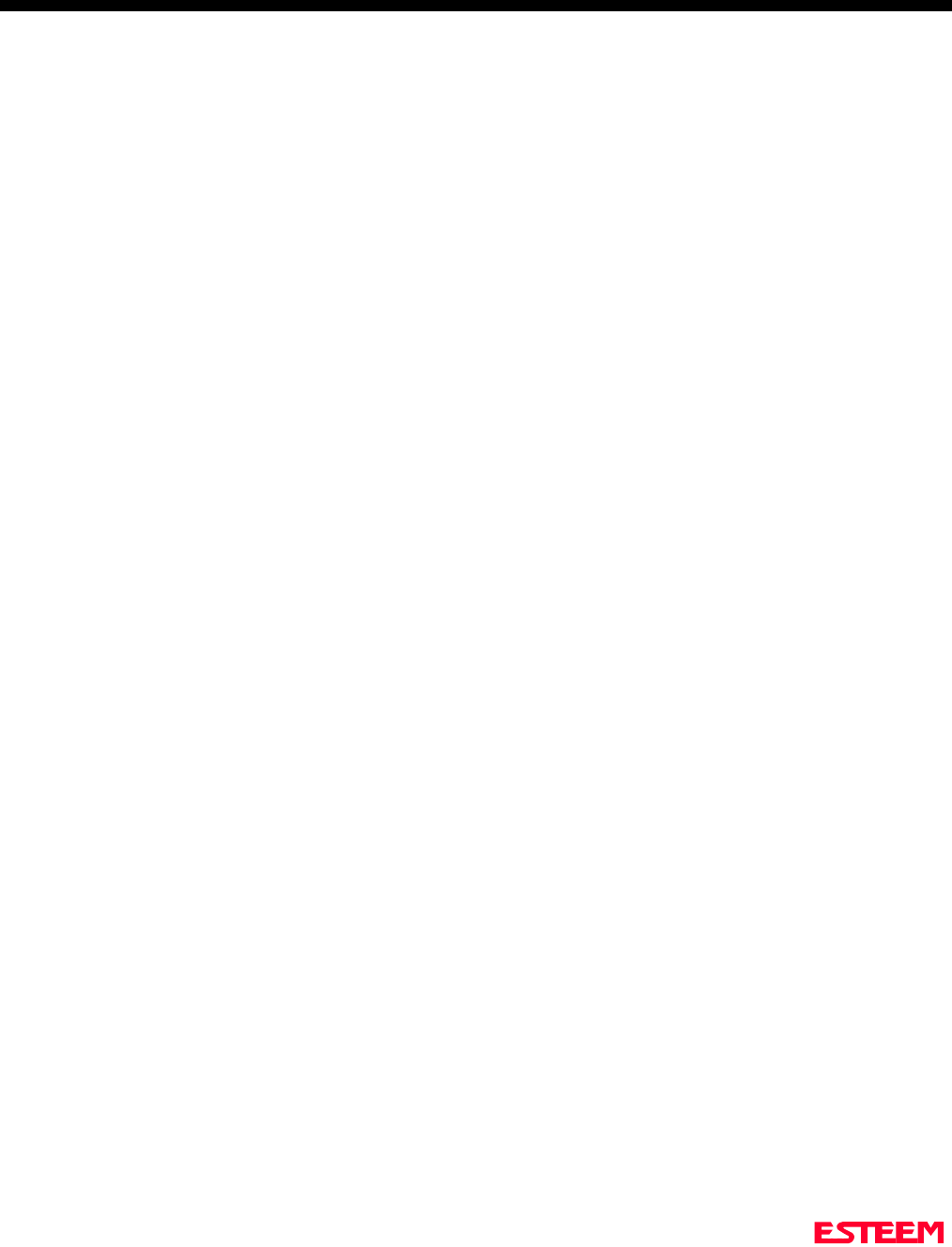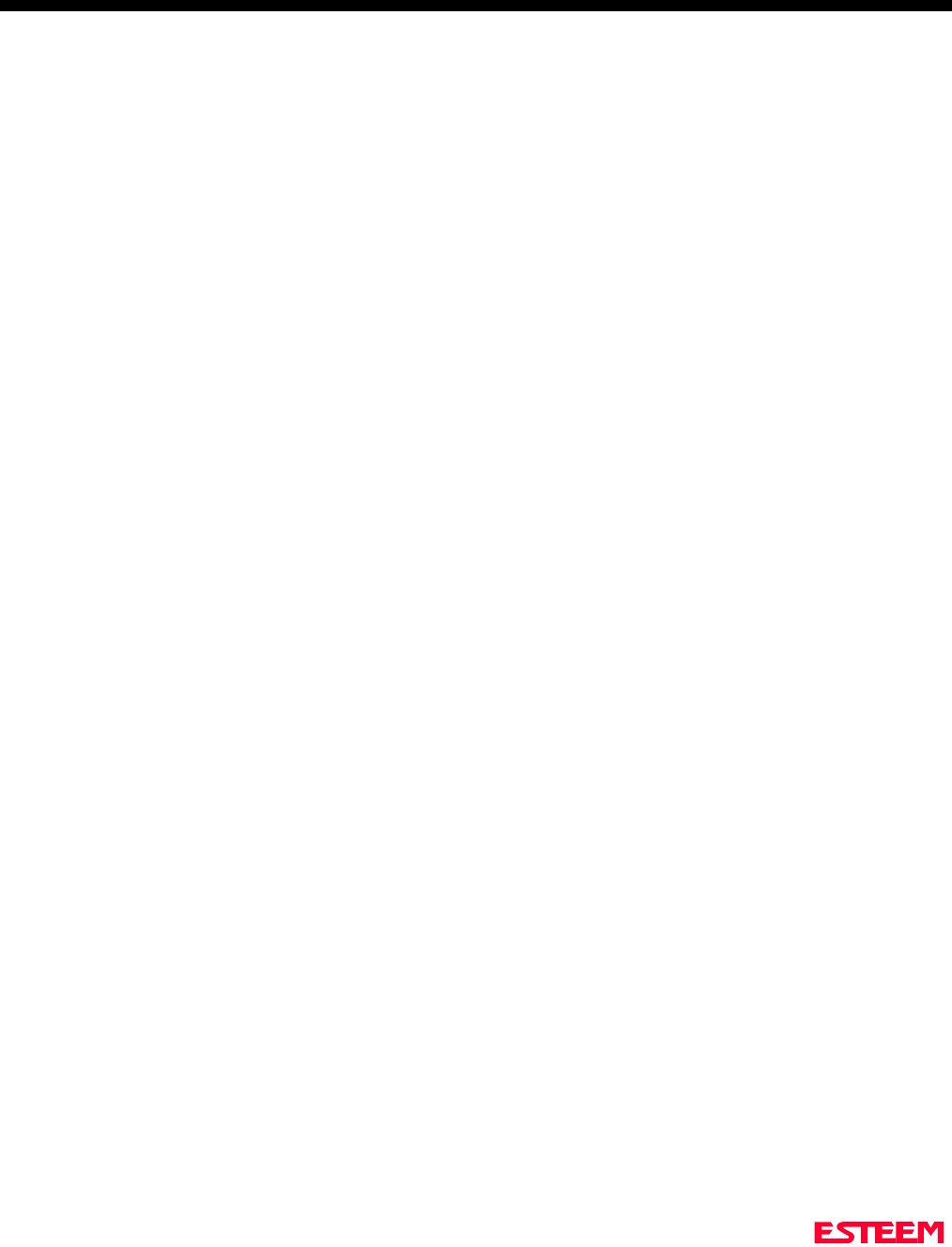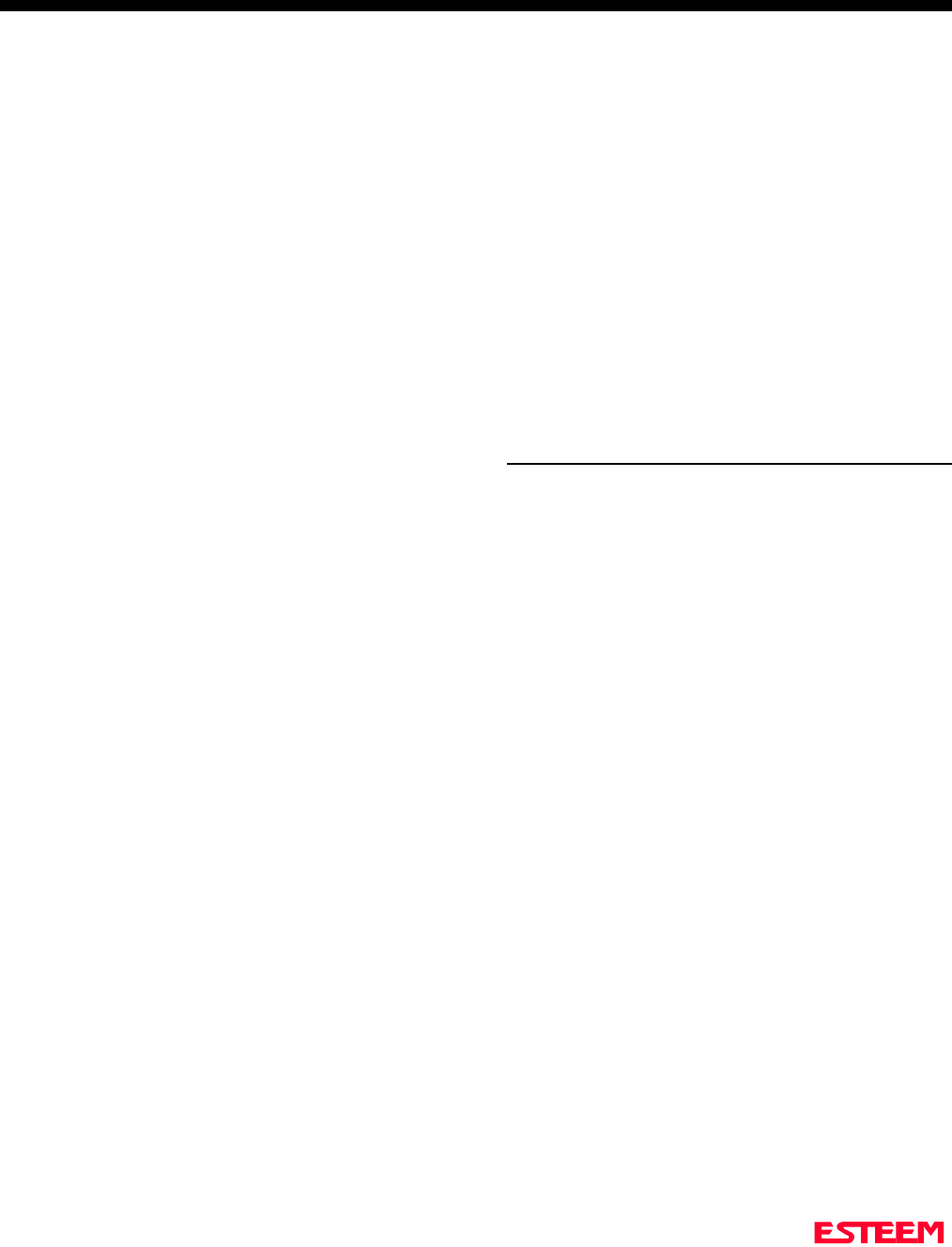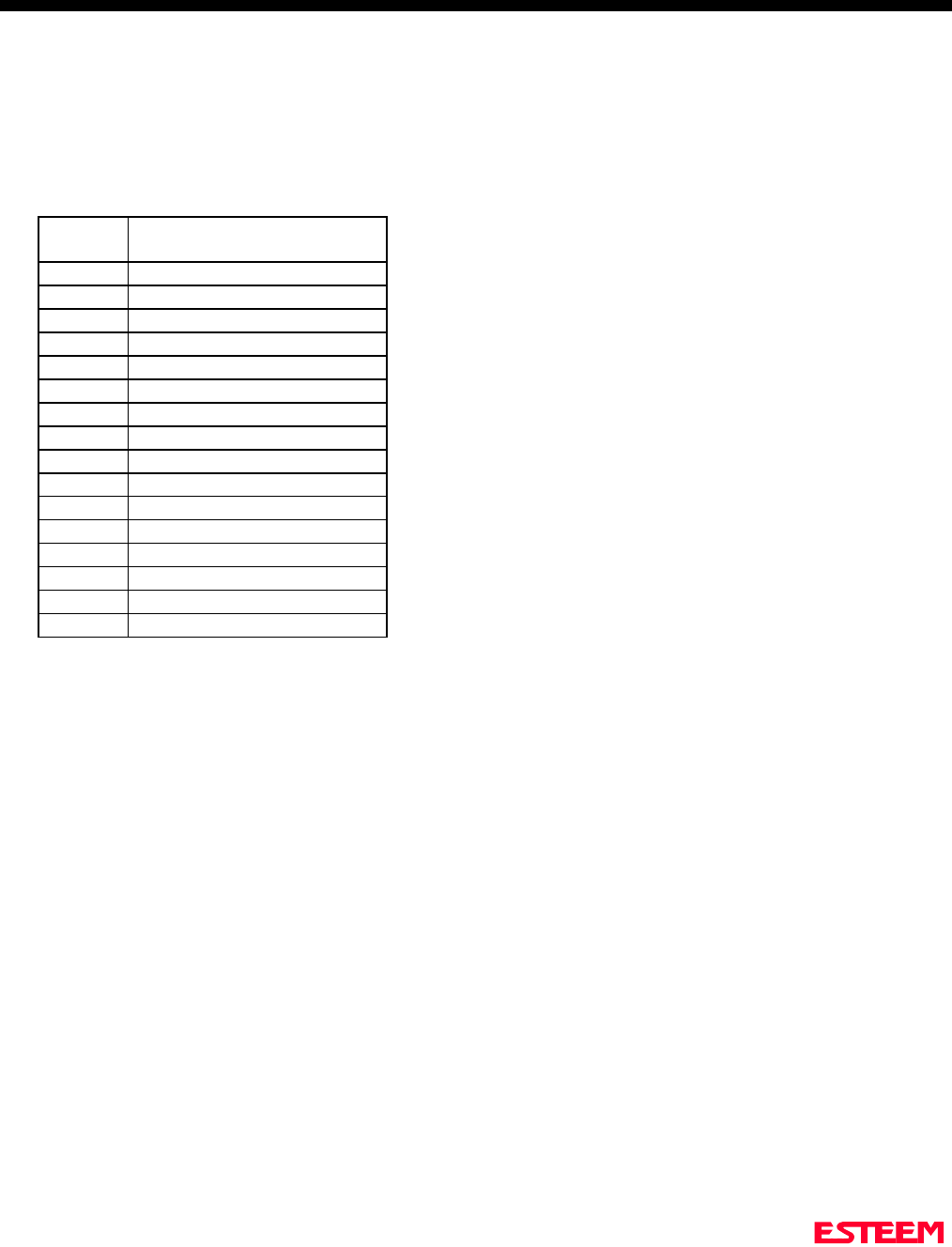Electronic Systems Technology ESTEEM192S Wireless Modem User Manual PART 5
Electronic Systems Technology Wireless Modem PART 5
Contents
USER MANUAL PART 5

CHAPTER 5
RS-232C/422/485 INTERFACING
DTE VS DCE
FLOW CONTROL
MEMORY BUFFERS
DATA TERMINAL READY
RS-422/485 CONFIGURATION
RS-232/422/485 PORT PINOUT TABLE

CHAPTER 5
RS-232C/422/485 INTERFACING
Revised: 11 Feb 99 5-2
DTE vs. DCE
The ESTeem is configured as a Data Communication
Equipment (DCE) device. The following signals are
available at the RS-232C connector located at the front of
the unit. Pin Description
---------------------------------------------------------------------
1 FG Shield Ground
2 TXD Transmit Data (Input)
3 RXD Receive Data (Output)
DCE 4 RTS Request To Send (Input)
5 CTS Clear to Send (Output)
7 SG Signal Ground
8 DCD Data Carrier Detect (Output)
12 RTS Request To Send (Output)
20 DTR Data Terminal Ready (Input)
22 Ring Ring Indicator (Output)
The important thing to remember is that for the ESTeem to
communicate with an external device, the data output from
pin 3 of the ESTeem RS-232C connector must be connected
to the data input of the device you are connected to;
otherwise, the ESTeem won't work. Likewise, the data
input to pin 2 of the ESTeem must be connected to the data
output of the device you are connected to. Normally, if the
equipment you are connecting to looks like a terminal or
computer (DTE), its input, Receive Data (RXD), will be on
pin 3 its output, Transmit Data (TXD), will be on pin 2.
Therefore, the ESTeem can be connected directly.
If the device you are connecting to is configured as a
modem (DCE), its output will be on pin 3. If this
configuration is connected to the ESTeem, damage may
result to the ESTeem or the connecting device. In this case,
you can purchase a null connector that internally reverses
pins 2 and 3.
Whatever your situation may be, it is always best to check
the manual on your particular device and connect
accordingly.
Purchase or fabricate a RS-232C shielded cable for your
ESTeem. The ESTeem requires a standard male 25 pin D
connector on one end of the cable for proper connection.
Remember to install the small retaining screws on either
side of the cable connector. Tightening these screws keeps
you from accidentally losing connection with your ESTeem.
Notes:
• The ESTeem requires a shielded RS-232 cable. This is
to prevent unwanted electrical noise from entering the
ESTeem and also to prevent any electrical noise from
getting out of the ESTeem.
• Remember -- always use a shielded RS-232C cable.
• Pins 9, 10, 14, & 16 are used for RS-422/485
interfacing and should be left open if not used.
FLOW CONTROL
The ESTeem can be enabled to support SOFTWARE or
HARDWARE flow control.
Software Flow Control
Software flow control is enabled by the XSFLOW (on/off)
command in the ESTeem. When XSFLOW is ON the
ESTeem will respond to <XOFF>, (stop) and <XON>, (off)
commands from the RS-232 port. The factory default
setting is ON. The default value for START is 17 (CTRL
Q) and for STOP is 19 (CTRL S).
Hardware Flow Control
Hardware flow control is enabled by the XHFLOW (on/off)
command in the ESTeem. The factory default value is
OFF.
When XHFLOW is enabled (on) the control signal lines,
Request To Send (RTS, pin 4), Data Carrier Detect (DCD,
pin 8), and Clear To Send (CTS, pin 5) are available to the
user at the RS-232C connector. The CTS and RTS signals
are used to control the flow of data into and out of the
ESTeem.
The CTS signal on pin 5 is used to control the data into the
ESTeem. When CTS is set (high on pin 5) the modem is
ready to receive data. When CTS is reset (low on pin 5) the
ESTeem is not ready to receive data.
The RTS signal is used to control data out of the
ESTeem. RTS is set (high on pin 4), by the user to indicate
to the ESTeem that the user is ready to receive data. When
reset, the user is not ready to receive data.
Note: Low = On, High = Off.
MEMORY BUFFERS
The ESTeem has a 4000 byte buffer on the TRANSMIT
SIDE (outgoing data) and a 4000 byte buffer on the
RECEIVE SIDE (incoming data).

CHAPTER 5
RS-232C/422/485 INTERFACING
Revised: 11 Feb 99 5-3
Transmit Buffer
The outgoing data buffer will hold two data blocks before
the ESTeem will enable its RS-232C hardware/software
flow control on data coming into the modem if the network
is busy. A data block in this example is a block of data that
is defined by the PACKLENGTH or SENDPAC character
which ever occurs first.
Therefore, if PACKLENGTH = 10 the modem will input a
maximum of 20 bytes before it enables its
hardware/software handshake line (two 10 byte packets). In
another example, if PACKLENGTH = 2000 but the data
block is terminated by the SENDPAC character before the
input buffer reaches the full 2000 bytes, the buffer will still
hold only two data blocks if the network is busy.
In order to utilize the 2000 bytes storage for small data
packets (bar code readers, etc.), program the modem using
the following guidelines:
PACKLENGTH = 2000 SENDPAC = 255
TERMC = ON TERMT = 10
Note: Set the TERMT time greater than the pause
between data bursts.
By programming the above parameters the ESTeem will
buffer the incoming data packets and automatically transmit
the data when the 2000 byte buffer is filled or the TERMT
time limit is met. This will allow the customer to use two
blocks of 2000 or 4000 bytes before the modem enables the
respect hardware/software control.
Receive Buffer
If the device that the receiving ESTeem is outputting data
to, enables its respective hardware or software control, the
modem will store 4000 bytes of data before flow controlling
off the transmitting ESTeem.
DATA TERMINAL READY (DTR)
A software switch, DTR_ENAB (ON/OFF) is provided in
the ESTeem for monitoring the status of a device connected
to pin 20 of the RS-232C connector. The factory default
setting is OFF. When this command is enabled the ESTeem
will monitor the DTR signal on pin 20. If the DTR line
being supplied to the ESTeem, from the user, is at a SPACE
(high) condition then the ESTeem is enabled. If the DTR
line is at a MARK (low) condition then the ESTeem is
disabled.
This signal is normally used by the ESTeem modem as an
indication that connection is made to a device that is on line
and ready to transmit/receive data.
RS-422/485 CONFIGURATION
The ESTeem will support the requirements of the EIA
Standard RS-422/485. This is a four (4) wire interface
consisting of the TRANSMIT DATA (-), TRANSMIT
DATA (+), RECEIVE DATA (-), AND RECEIVE DATA
(+). These signals are available at the 25 pin RS-232C
connector on the modem.
Pin Description
9 BTR (-) TRANSMIT DATA (-)
10 BTR (+) TRANSMIT DATA (+)
DCE 14 BRX (+) RECEIVE DATA (+)
16 BRX (-) RECEIVE DATA (-)
This interface is designed to provide unipolar differential
drive to twisted pair or parallel wire transmission lines.
Note: The ESTeem can be factory configured for 2-wire
RS-485 interfacing. Call EST Customer Support
on 509-735-9092.

CHAPTER 5
RS-232C/422/485 INTERFACING
Revised: 11 Feb 99 5-4
Refer to Chapter 1 “Starting Out” to set the ESTeem RS-
232 data rate.
ESTeem RS-232C/422/485
Port Pin-Out Table
Pin No. Function
1Shield Ground
2Transmit Data (TxD)
3Receive Data (RxD)
4Request To Send (RTS Input)
5Clear To Send (CTS)
6Data Set Ready (DSR)
7Signal Ground
8Data Carrier Detect (DCD)
19 Mode Control
20 Data Terminal Ready (DTR)
22 Ring Indicator (RI)
12 Request To Send (RTS Output)
9RS-422/485 Transmit Data (-)
10 RS-422/485 Transmit Data (+)
14 RS-422/485 Receive Data (+)
16 RS-422/485 Receive Data (-)